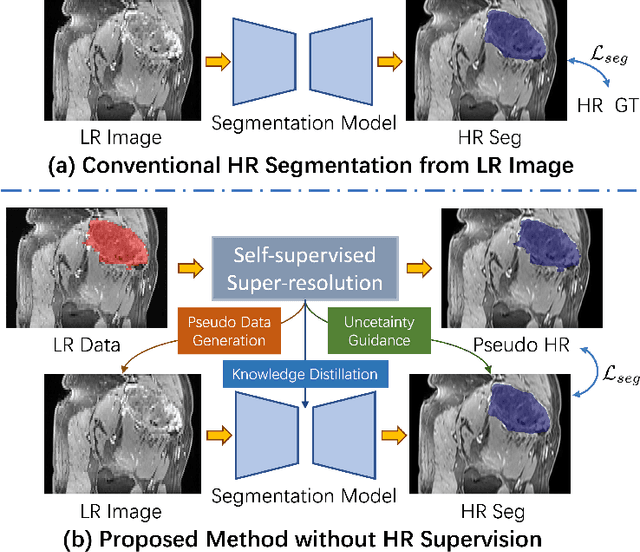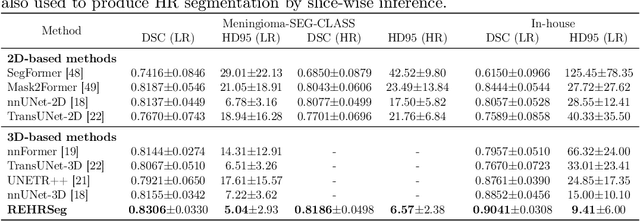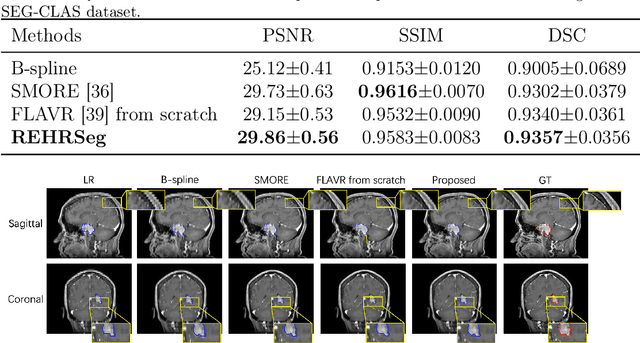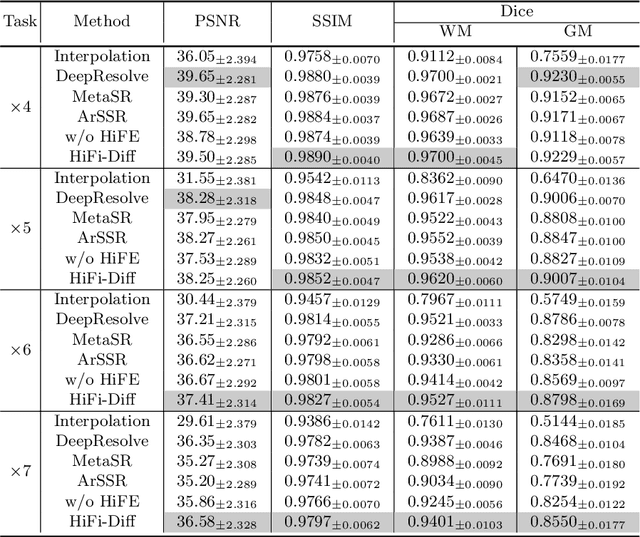Mengjun Liu
REHRSeg: Unleashing the Power of Self-Supervised Super-Resolution for Resource-Efficient 3D MRI Segmentation
Oct 14, 2024



Abstract:High-resolution (HR) 3D magnetic resonance imaging (MRI) can provide detailed anatomical structural information, enabling precise segmentation of regions of interest for various medical image analysis tasks. Due to the high demands of acquisition device, collection of HR images with their annotations is always impractical in clinical scenarios. Consequently, segmentation results based on low-resolution (LR) images with large slice thickness are often unsatisfactory for subsequent tasks. In this paper, we propose a novel Resource-Efficient High-Resolution Segmentation framework (REHRSeg) to address the above-mentioned challenges in real-world applications, which can achieve HR segmentation while only employing the LR images as input. REHRSeg is designed to leverage self-supervised super-resolution (self-SR) to provide pseudo supervision, therefore the relatively easier-to-acquire LR annotated images generated by 2D scanning protocols can be directly used for model training. The main contribution to ensure the effectiveness in self-SR for enhancing segmentation is three-fold: (1) We mitigate the data scarcity problem in the medical field by using pseudo-data for training the segmentation model. (2) We design an uncertainty-aware super-resolution (UASR) head in self-SR to raise the awareness of segmentation uncertainty as commonly appeared on the ROI boundaries. (3) We align the spatial features for self-SR and segmentation through structural knowledge distillation to enable a better capture of region correlations. Experimental results demonstrate that REHRSeg achieves high-quality HR segmentation without intensive supervision, while also significantly improving the baseline performance for LR segmentation.
Arbitrary Reduction of MRI Inter-slice Spacing Using Hierarchical Feature Conditional Diffusion
Apr 18, 2023



Abstract:Magnetic resonance (MR) images collected in 2D scanning protocols typically have large inter-slice spacing, resulting in high in-plane resolution but reduced through-plane resolution. Super-resolution techniques can reduce the inter-slice spacing of 2D scanned MR images, facilitating the downstream visual experience and computer-aided diagnosis. However, most existing super-resolution methods are trained at a fixed scaling ratio, which is inconvenient in clinical settings where MR scanning may have varying inter-slice spacings. To solve this issue, we propose Hierarchical Feature Conditional Diffusion (HiFi-Diff)} for arbitrary reduction of MR inter-slice spacing. Given two adjacent MR slices and the relative positional offset, HiFi-Diff can iteratively convert a Gaussian noise map into any desired in-between MR slice. Furthermore, to enable fine-grained conditioning, the Hierarchical Feature Extraction (HiFE) module is proposed to hierarchically extract conditional features and conduct element-wise modulation. Our experimental results on the publicly available HCP-1200 dataset demonstrate the high-fidelity super-resolution capability of HiFi-Diff and its efficacy in enhancing downstream segmentation performance.
Emerging Threats in Deep Learning-Based Autonomous Driving: A Comprehensive Survey
Oct 19, 2022



Abstract:Since the 2004 DARPA Grand Challenge, the autonomous driving technology has witnessed nearly two decades of rapid development. Particularly, in recent years, with the application of new sensors and deep learning technologies extending to the autonomous field, the development of autonomous driving technology has continued to make breakthroughs. Thus, many carmakers and high-tech giants dedicated to research and system development of autonomous driving. However, as the foundation of autonomous driving, the deep learning technology faces many new security risks. The academic community has proposed deep learning countermeasures against the adversarial examples and AI backdoor, and has introduced them into the autonomous driving field for verification. Deep learning security matters to autonomous driving system security, and then matters to personal safety, which is an issue that deserves attention and research.This paper provides an summary of the concepts, developments and recent research in deep learning security technologies in autonomous driving. Firstly, we briefly introduce the deep learning framework and pipeline in the autonomous driving system, which mainly include the deep learning technologies and algorithms commonly used in this field. Moreover, we focus on the potential security threats of the deep learning based autonomous driving system in each functional layer in turn. We reviews the development of deep learning attack technologies to autonomous driving, investigates the State-of-the-Art algorithms, and reveals the potential risks. At last, we provides an outlook on deep learning security in the autonomous driving field and proposes recommendations for building a safe and trustworthy autonomous driving system.
 Add to Chrome
Add to Chrome Add to Firefox
Add to Firefox Add to Edge
Add to Edge